

Compact Muon Solenoid
LHC, CERN
| CMS-B2G-18-008 ; CERN-EP-2019-056 | ||
| Search for resonances decaying to a pair of Higgs bosons in the $\mathrm{b\bar{b}}\mathrm{q\bar{q}}'\ell\nu$ final state in proton-proton collisions at $\sqrt{s} = $ 13 TeV | ||
| CMS Collaboration | ||
| 8 April 2019 | ||
| JHEP 10 (2019) 125 | ||
| Abstract: A search for new massive particles decaying into a pair of Higgs bosons in proton-proton collisions at a center-of-mass energy of 13 TeV is presented. Data were collected with the CMS detector at the LHC, corresponding to an integrated luminosity of 35.9 fb$^{-1}$. The search is performed for resonances with a mass between 0.8 and 3.5 TeV using events in which one Higgs boson decays into a bottom quark pair and the other decays into two W bosons that subsequently decay into a lepton, a neutrino, and a quark pair. The Higgs boson decays are reconstructed with techniques that identify final state quarks as substructure within boosted jets. The data are consistent with standard model expectations. Exclusion limits are placed on the product of the cross section and branching fraction for generic spin-0 and spin-2 massive resonances. The results are interpreted in the context of radion and bulk graviton production in models with a warped extra spatial dimension. These are the best results to date from searches for an HH resonance decaying to this final state, and they are comparable to the results from searches in other channels for resonances with masses below 1.5 TeV. | ||
| Links: e-print arXiv:1904.04193 [hep-ex] (PDF) ; CDS record ; inSPIRE record ; HepData record ; CADI line (restricted) ; | ||
| Figures | |

png pdf |
Figure 1:
Pre-modeling and pre-fit distributions of the discriminating variables, which are described in the text, are shown for data (points) and SM processes (filled histograms) as predicted directly from simulation. The statistical uncertainty of the simulated sample is shown as the hatched band. The solid lines correspond to spin-0 signals for $ {m_{{\text {X}}}} $ of 1 and 2.5 TeV. The product of the cross section and branching fraction to two Higgs bosons is set to 2 pb for both signal models. The lower panels show the ratio of the data to the sum of all background processes. |
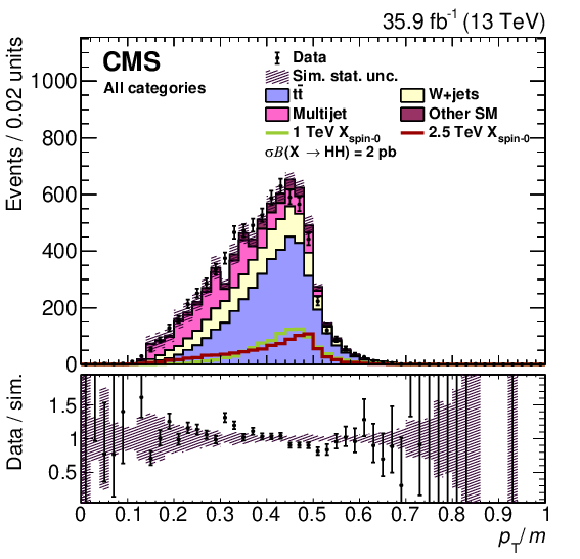
png pdf |
Figure 1-a:
The pre-modeling and pre-fit distributions of the $p_{\mathrm{T}}/m$ discriminating variable is shown for data (points) and SM processes (filled histograms) as predicted directly from simulation. The statistical uncertainty of the simulated sample is shown as the hatched band. The solid lines correspond to spin-0 signals for $ {m_{{\text {X}}}} $ of 1 and 2.5 TeV. The product of the cross section and branching fraction to two Higgs bosons is set to 2 pb for both signal models. The lower panel shows the ratio of the data to the sum of all background processes. |
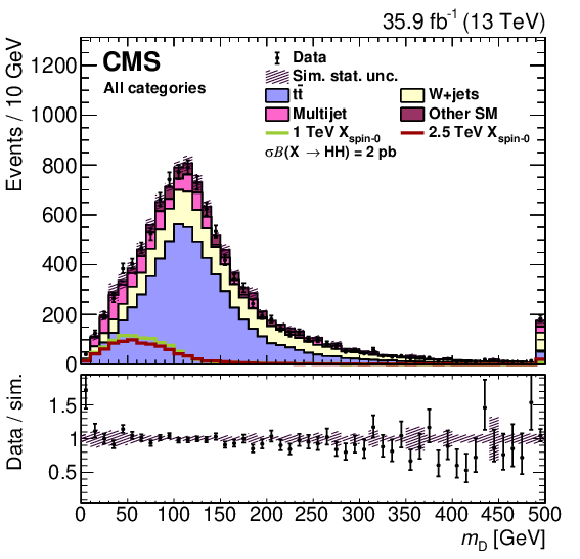
png pdf |
Figure 1-b:
The pre-modeling and pre-fit distributions of the $m_{\mathrm{D}}$ discriminating variable is shown for data (points) and SM processes (filled histograms) as predicted directly from simulation. The statistical uncertainty of the simulated sample is shown as the hatched band. The solid lines correspond to spin-0 signals for $ {m_{{\text {X}}}} $ of 1 and 2.5 TeV. The product of the cross section and branching fraction to two Higgs bosons is set to 2 pb for both signal models. The lower panel shows the ratio of the data to the sum of all background processes. |

png pdf |
Figure 1-c:
The pre-modeling and pre-fit distributions of the $\mathrm{q\bar{q}'} \tau_{2}/\tau_{1}$ discriminating variable is shown for data (points) and SM processes (filled histograms) as predicted directly from simulation. The statistical uncertainty of the simulated sample is shown as the hatched band. The solid lines correspond to spin-0 signals for $ {m_{{\text {X}}}} $ of 1 and 2.5 TeV. The product of the cross section and branching fraction to two Higgs bosons is set to 2 pb for both signal models. The lower panel shows the ratio of the data to the sum of all background processes. |

png pdf |
Figure 1-d:
The pre-modeling and pre-fit distributions of the $m_{\mathrm{b\bar{b}}}$ discriminating variable is shown for data (points) and SM processes (filled histograms) as predicted directly from simulation. The statistical uncertainty of the simulated sample is shown as the hatched band. The solid lines correspond to spin-0 signals for $ {m_{{\text {X}}}} $ of 1 and 2.5 TeV. The product of the cross section and branching fraction to two Higgs bosons is set to 2 pb for both signal models. The lower panel shows the ratio of the data to the sum of all background processes. |

png pdf |
Figure 2:
The fit result compared to data in the $ {{\mathrm {t}\overline {\mathrm {t}}}} $ CR (upper plots) and ${{\mathrm {q}}/ {\mathrm {g}}}$ CR (lower plots), projected in ${m_{{{\mathrm {b}} {\overline {\mathrm {b}}}}}}$ (left) and ${m_{{\mathrm {H}} {\mathrm {H}}}}$ (right). Events from all categories are combined. The fit result is the filled histogram, with the different colors indicating different background categories. The background shape uncertainty is shown as the hatched band. The lower panels show ratio of the data to the fit result. |
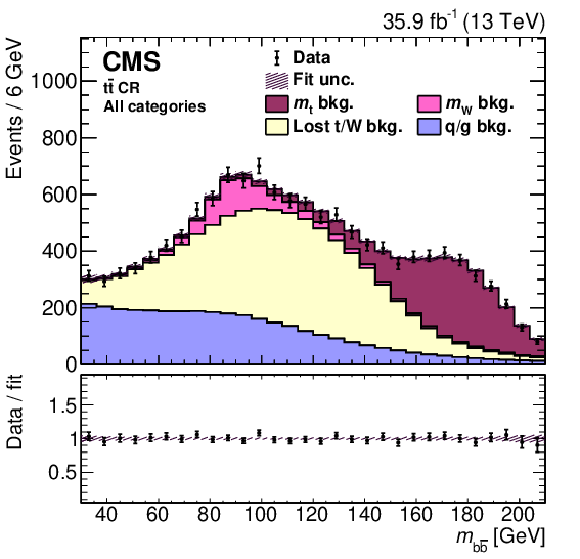
png pdf |
Figure 2-a:
The fit result compared to data in the $ {{\mathrm {t}\overline {\mathrm {t}}}} $ CR, projected in |
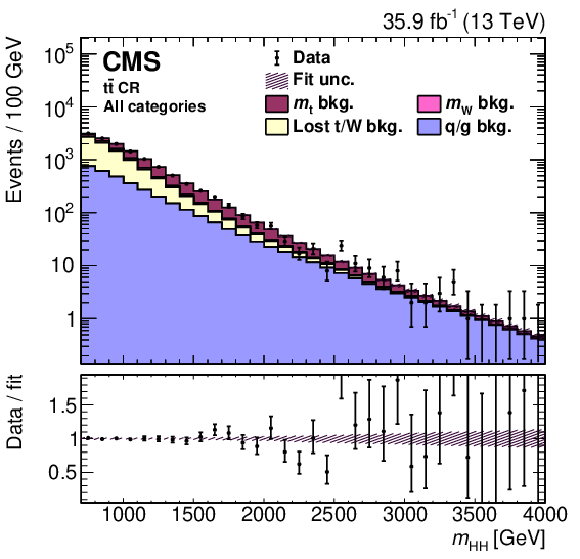
png pdf |
Figure 2-b:
The fit result compared to data in the $ {{\mathrm {t}\overline {\mathrm {t}}}} $ CR, projected in ${m_{{\mathrm {H}} {\mathrm {H}}}}$. Events from all categories are combined. The fit result is the filled histogram, with the different colors indicating different background categories. The background shape uncertainty is shown as the hatched band. The lower panel shows ratio of the data to the fit result. |
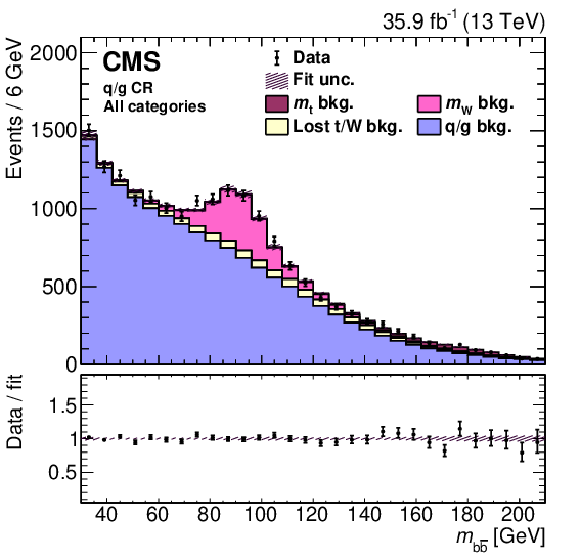
png pdf |
Figure 2-c:
The fit result compared to data in the ${{\mathrm {q}}/ {\mathrm {g}}}$ CR, |

png pdf |
Figure 2-d:
The fit result compared to data in the ${{\mathrm {q}}/ {\mathrm {g}}}$ CR, projected in ${m_{{\mathrm {H}} {\mathrm {H}}}}$. Events from all categories are combined. The fit result is the filled histogram, with the different colors indicating different background categories. The background shape uncertainty is shown as the hatched band. The lower panel shows ratio of the data to the fit result. |
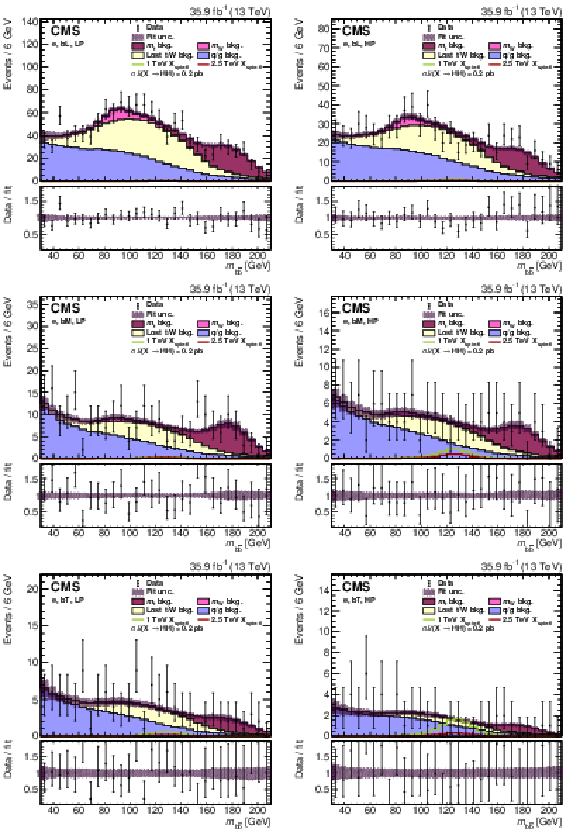
png pdf |
Figure 3:
The fit result compared to data projected in ${m_{{{\mathrm {b}} {\overline {\mathrm {b}}}}}}$ for the electron event categories. The fit result is the filled histogram, with the different colors indicating different background categories. The background shape uncertainty is shown as the hatched band. Example spin-0 signal distributions for $ {m_{{\text {X}}}} $ of 1 and 2.5 TeV are shown as solid lines, with the product of the cross section and branching fraction to two Higgs bosons set to 0.2 pb. The lower panels show ratio of the data to the fit result. |
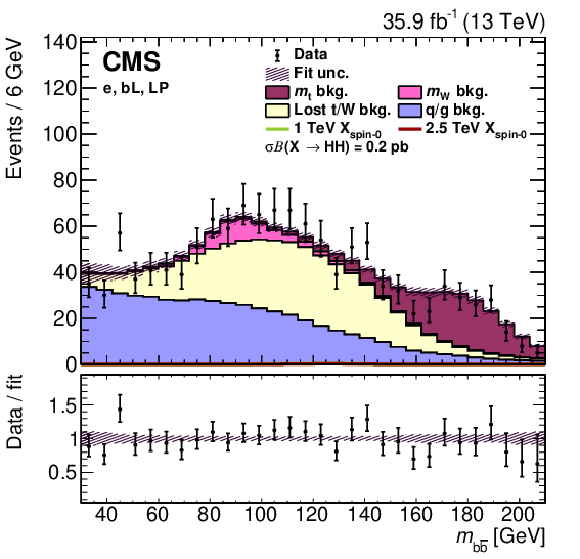
png pdf |
Figure 3-a:
The fit result compared to data projected in ${m_{{{\mathrm {b}} {\overline {\mathrm {b}}}}}}$ for the e, bL, LP electron event category. The fit result is the filled histogram, with the different colors indicating different background categories. The background shape uncertainty is shown as the hatched band. Example spin-0 signal distributions for $ {m_{{\text {X}}}} $ of 1 and 2.5 TeV are shown as solid lines, with the product of the cross section and branching fraction to two Higgs bosons set to 0.2 pb. The lower panel shows ratio of the data to the fit result. |

png pdf |
Figure 3-b:
The fit result compared to data projected in ${m_{{{\mathrm {b}} {\overline {\mathrm {b}}}}}}$ for the e, bL, HP electron event category. The fit result is the filled histogram, with the different colors indicating different background categories. The background shape uncertainty is shown as the hatched band. Example spin-0 signal distributions for $ {m_{{\text {X}}}} $ of 1 and 2.5 TeV are shown as solid lines, with the product of the cross section and branching fraction to two Higgs bosons set to 0.2 pb. The lower panel shows ratio of the data to the fit result. |
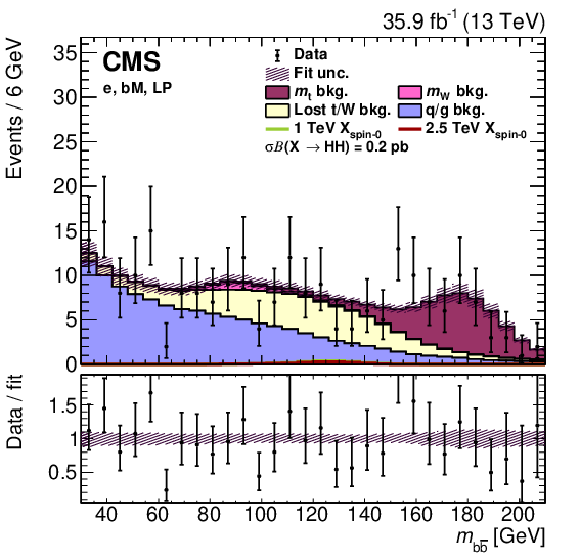
png pdf |
Figure 3-c:
The fit result compared to data projected in ${m_{{{\mathrm {b}} {\overline {\mathrm {b}}}}}}$ for the e, bM, LP electron event category. The fit result is the filled histogram, with the different colors indicating different background categories. The background shape uncertainty is shown as the hatched band. Example spin-0 signal distributions for $ {m_{{\text {X}}}} $ of 1 and 2.5 TeV are shown as solid lines, with the product of the cross section and branching fraction to two Higgs bosons set to 0.2 pb. The lower panel shows ratio of the data to the fit result. |

png pdf |
Figure 3-d:
The fit result compared to data projected in ${m_{{{\mathrm {b}} {\overline {\mathrm {b}}}}}}$ for the e, bM, HP electron event category. The fit result is the filled histogram, with the different colors indicating different background categories. The background shape uncertainty is shown as the hatched band. Example spin-0 signal distributions for $ {m_{{\text {X}}}} $ of 1 and 2.5 TeV are shown as solid lines, with the product of the cross section and branching fraction to two Higgs bosons set to 0.2 pb. The lower panel shows ratio of the data to the fit result. |
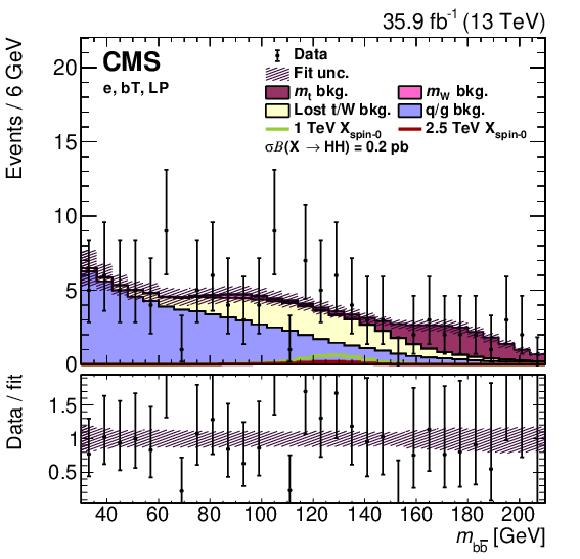
png pdf |
Figure 3-e:
The fit result compared to data projected in ${m_{{{\mathrm {b}} {\overline {\mathrm {b}}}}}}$ for the e, bT, LP electron event category. The fit result is the filled histogram, with the different colors indicating different background categories. The background shape uncertainty is shown as the hatched band. Example spin-0 signal distributions for $ {m_{{\text {X}}}} $ of 1 and 2.5 TeV are shown as solid lines, with the product of the cross section and branching fraction to two Higgs bosons set to 0.2 pb. The lower panel shows ratio of the data to the fit result. |

png pdf |
Figure 3-f:
The fit result compared to data projected in ${m_{{{\mathrm {b}} {\overline {\mathrm {b}}}}}}$ for the e, bT, HP electron event category. The fit result is the filled histogram, with the different colors indicating different background categories. The background shape uncertainty is shown as the hatched band. Example spin-0 signal distributions for $ {m_{{\text {X}}}} $ of 1 and 2.5 TeV are shown as solid lines, with the product of the cross section and branching fraction to two Higgs bosons set to 0.2 pb. The lower panel shows ratio of the data to the fit result. |

png pdf |
Figure 4:
The fit result compared to data projected in ${m_{{{\mathrm {b}} {\overline {\mathrm {b}}}}}}$ for the muon event categories. The fit result is the filled histogram, with the different colors indicating different background categories. The background shape uncertainty is shown as the hatched band. Example spin-0 signal distributions for $ {m_{{\text {X}}}} $ of 1 and 2.5 TeV are shown as solid lines, with the product of the cross section and branching fraction to two Higgs bosons set to 0.2 pb. The lower panels show ratio of the data to the fit result. |

png pdf |
Figure 4-a:
The fit result compared to data projected in ${m_{{{\mathrm {b}} {\overline {\mathrm {b}}}}}}$ for the $\mu$, bL, LP muon event category. The fit result is the filled histogram, with the different colors indicating different background categories. The background shape uncertainty is shown as the hatched band. Example spin-0 signal distributions for $ {m_{{\text {X}}}} $ of 1 and 2.5 TeV are shown as solid lines, with the product of the cross section and branching fraction to two Higgs bosons set to 0.2 pb. The lower panel shows ratio of the data to the fit result. |

png pdf |
Figure 4-b:
The fit result compared to data projected in ${m_{{{\mathrm {b}} {\overline {\mathrm {b}}}}}}$ for the $\mu$, bL, HP muon event category. The fit result is the filled histogram, with the different colors indicating different background categories. The background shape uncertainty is shown as the hatched band. Example spin-0 signal distributions for $ {m_{{\text {X}}}} $ of 1 and 2.5 TeV are shown as solid lines, with the product of the cross section and branching fraction to two Higgs bosons set to 0.2 pb. The lower panel shows ratio of the data to the fit result. |
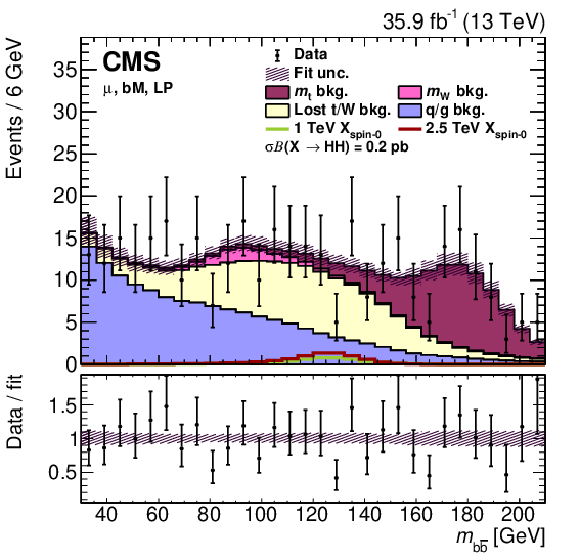
png pdf |
Figure 4-c:
The fit result compared to data projected in ${m_{{{\mathrm {b}} {\overline {\mathrm {b}}}}}}$ for the $\mu$, bM, LP muon event category. The fit result is the filled histogram, with the different colors indicating different background categories. The background shape uncertainty is shown as the hatched band. Example spin-0 signal distributions for $ {m_{{\text {X}}}} $ of 1 and 2.5 TeV are shown as solid lines, with the product of the cross section and branching fraction to two Higgs bosons set to 0.2 pb. The lower panel shows ratio of the data to the fit result. |
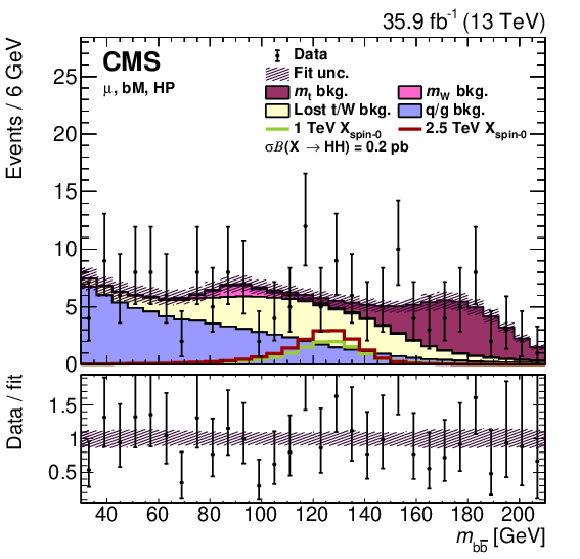
png pdf |
Figure 4-d:
The fit result compared to data projected in ${m_{{{\mathrm {b}} {\overline {\mathrm {b}}}}}}$ for the $\mu$, bM, HP muon event category. The fit result is the filled histogram, with the different colors indicating different background categories. The background shape uncertainty is shown as the hatched band. Example spin-0 signal distributions for $ {m_{{\text {X}}}} $ of 1 and 2.5 TeV are shown as solid lines, with the product of the cross section and branching fraction to two Higgs bosons set to 0.2 pb. The lower panel shows ratio of the data to the fit result. |
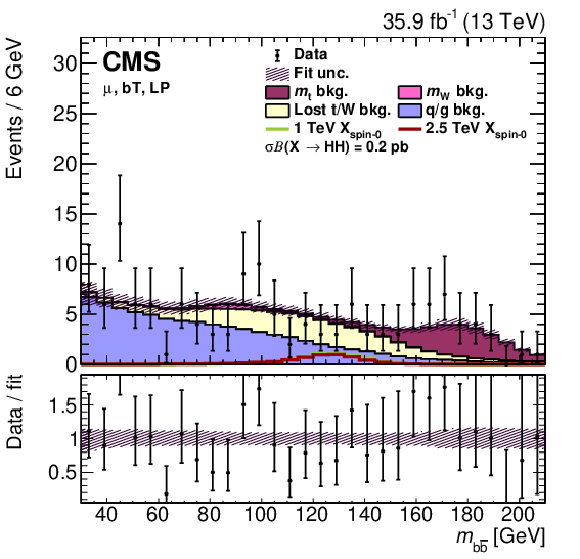
png pdf |
Figure 4-e:
The fit result compared to data projected in ${m_{{{\mathrm {b}} {\overline {\mathrm {b}}}}}}$ for the $\mu$, bT, LP muon event category. The fit result is the filled histogram, with the different colors indicating different background categories. The background shape uncertainty is shown as the hatched band. Example spin-0 signal distributions for $ {m_{{\text {X}}}} $ of 1 and 2.5 TeV are shown as solid lines, with the product of the cross section and branching fraction to two Higgs bosons set to 0.2 pb. The lower panel shows ratio of the data to the fit result. |

png pdf |
Figure 4-f:
The fit result compared to data projected in ${m_{{{\mathrm {b}} {\overline {\mathrm {b}}}}}}$ for the $\mu$, bT, HP muon event category. The fit result is the filled histogram, with the different colors indicating different background categories. The background shape uncertainty is shown as the hatched band. Example spin-0 signal distributions for $ {m_{{\text {X}}}} $ of 1 and 2.5 TeV are shown as solid lines, with the product of the cross section and branching fraction to two Higgs bosons set to 0.2 pb. The lower panel shows ratio of the data to the fit result. |
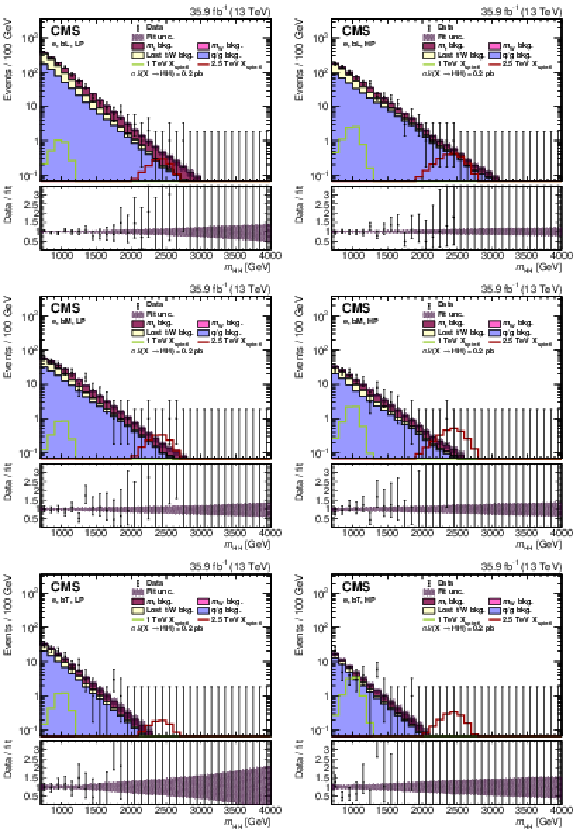
png pdf |
Figure 5:
The fit result compared to data projected in ${m_{{\mathrm {H}} {\mathrm {H}}}}$ for the electron event categories. The fit result is the filled histogram, with the different colors indicating different background categories. The background shape uncertainty is shown as the hatched band. Example spin-0 signal distributions for $ {m_{{\text {X}}}} $ of 1 and 2.5 TeV are shown as solid lines, with the product of the cross section and branching fraction to two Higgs bosons set to 0.2 pb. The lower panels show ratio of the data to the fit result. |
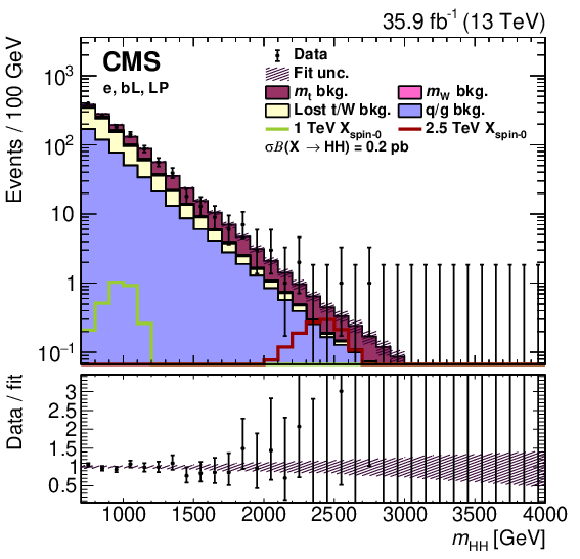
png pdf |
Figure 5-a:
The fit result compared to data projected in ${m_{{\mathrm {H}} {\mathrm {H}}}}$ for the e, bL, LP electron event category. The fit result is the filled histogram, with the different colors indicating different background categories. The background shape uncertainty is shown as the hatched band. Example spin-0 signal distributions for $ {m_{{\text {X}}}} $ of 1 and 2.5 TeV are shown as solid lines, with the product of the cross section and branching fraction to two Higgs bosons set to 0.2 pb. The lower panel shows ratio of the data to the fit result. |

png pdf |
Figure 5-b:
The fit result compared to data projected in ${m_{{\mathrm {H}} {\mathrm {H}}}}$ for the e, bL, HP electron event category. The fit result is the filled histogram, with the different colors indicating different background categories. The background shape uncertainty is shown as the hatched band. Example spin-0 signal distributions for $ {m_{{\text {X}}}} $ of 1 and 2.5 TeV are shown as solid lines, with the product of the cross section and branching fraction to two Higgs bosons set to 0.2 pb. The lower panel shows ratio of the data to the fit result. |

png pdf |
Figure 5-c:
The fit result compared to data projected in ${m_{{\mathrm {H}} {\mathrm {H}}}}$ for the e, bM, LP electron event category. The fit result is the filled histogram, with the different colors indicating different background categories. The background shape uncertainty is shown as the hatched band. Example spin-0 signal distributions for $ {m_{{\text {X}}}} $ of 1 and 2.5 TeV are shown as solid lines, with the product of the cross section and branching fraction to two Higgs bosons set to 0.2 pb. The lower panel shows ratio of the data to the fit result. |
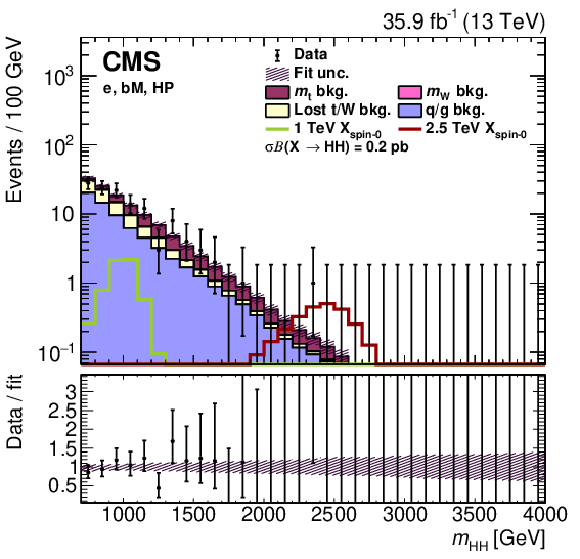
png pdf |
Figure 5-d:
The fit result compared to data projected in ${m_{{\mathrm {H}} {\mathrm {H}}}}$ for the e, bM, HP electron event category. The fit result is the filled histogram, with the different colors indicating different background categories. The background shape uncertainty is shown as the hatched band. Example spin-0 signal distributions for $ {m_{{\text {X}}}} $ of 1 and 2.5 TeV are shown as solid lines, with the product of the cross section and branching fraction to two Higgs bosons set to 0.2 pb. The lower panel shows ratio of the data to the fit result. |
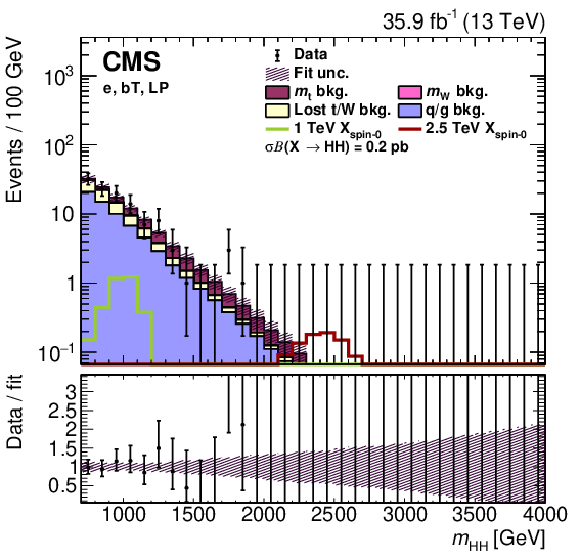
png pdf |
Figure 5-e:
The fit result compared to data projected in ${m_{{\mathrm {H}} {\mathrm {H}}}}$ for the e, bT, LP electron event category. The fit result is the filled histogram, with the different colors indicating different background categories. The background shape uncertainty is shown as the hatched band. Example spin-0 signal distributions for $ {m_{{\text {X}}}} $ of 1 and 2.5 TeV are shown as solid lines, with the product of the cross section and branching fraction to two Higgs bosons set to 0.2 pb. The lower panel shows ratio of the data to the fit result. |
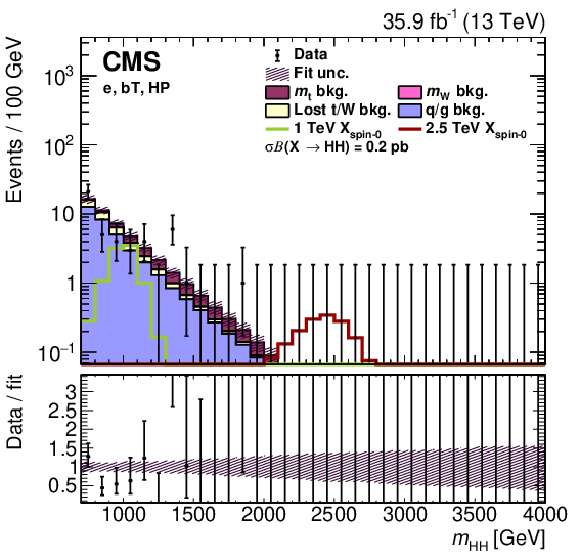
png pdf |
Figure 5-f:
The fit result compared to data projected in ${m_{{\mathrm {H}} {\mathrm {H}}}}$ for the e, bT, HP electron event category. The fit result is the filled histogram, with the different colors indicating different background categories. The background shape uncertainty is shown as the hatched band. Example spin-0 signal distributions for $ {m_{{\text {X}}}} $ of 1 and 2.5 TeV are shown as solid lines, with the product of the cross section and branching fraction to two Higgs bosons set to 0.2 pb. The lower panel shows ratio of the data to the fit result. |
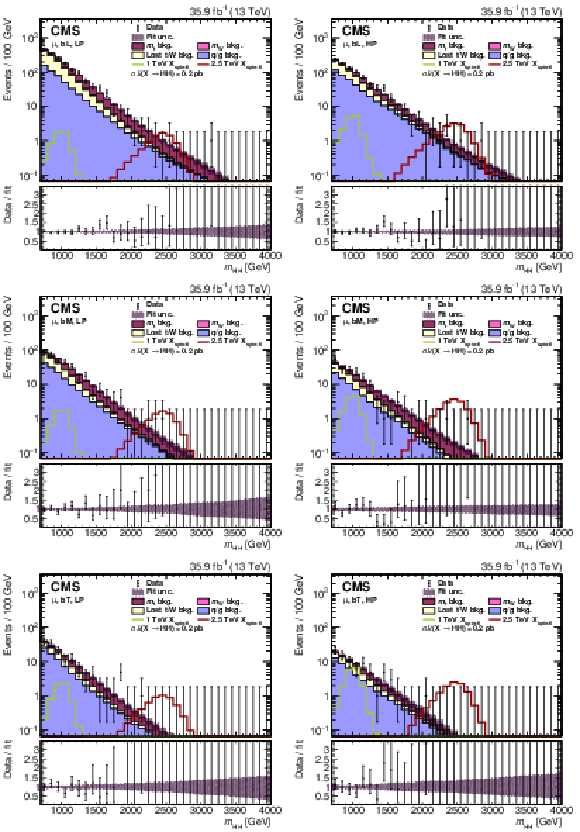
png pdf |
Figure 6:
The fit result compared to data projected in ${m_{{\mathrm {H}} {\mathrm {H}}}}$ for the muon event categories. The fit result is the filled histogram, with the different colors indicating different background categories. The background shape uncertainty is shown as the hatched band. Example spin-0 signal distributions for $ {m_{{\text {X}}}} $ of 1 and 2.5 TeV are shown as solid lines, with the product of the cross section and branching fraction to two Higgs bosons set to 0.2 pb. The lower panels show ratio of the data to the fit result. |

png pdf |
Figure 6-a:
The fit result compared to data projected in ${m_{{\mathrm {H}} {\mathrm {H}}}}$ for the muon $\mu$, bL, LP event category. The fit result is the filled histogram, with the different colors indicating different background categories. The background shape uncertainty is shown as the hatched band. Example spin-0 signal distributions for $ {m_{{\text {X}}}} $ of 1 and 2.5 TeV are shown as solid lines, with the product of the cross section and branching fraction to two Higgs bosons set to 0.2 pb. The lower panel shows ratio of the data to the fit result. |

png pdf |
Figure 6-b:
The fit result compared to data projected in ${m_{{\mathrm {H}} {\mathrm {H}}}}$ for the muon $\mu$, bL, HP event category. The fit result is the filled histogram, with the different colors indicating different background categories. The background shape uncertainty is shown as the hatched band. Example spin-0 signal distributions for $ {m_{{\text {X}}}} $ of 1 and 2.5 TeV are shown as solid lines, with the product of the cross section and branching fraction to two Higgs bosons set to 0.2 pb. The lower panel shows ratio of the data to the fit result. |
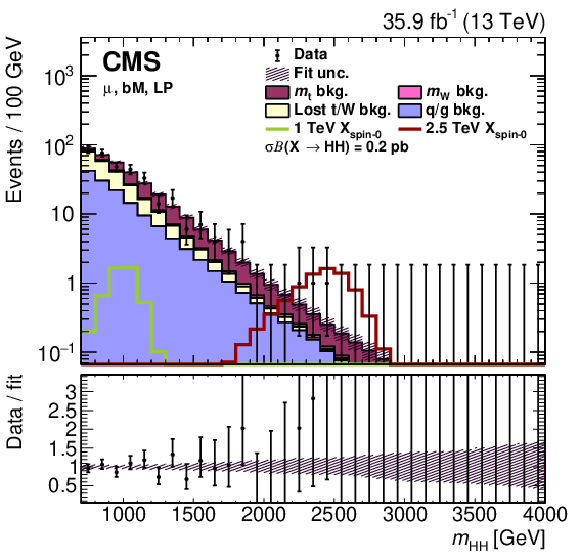
png pdf |
Figure 6-c:
The fit result compared to data projected in ${m_{{\mathrm {H}} {\mathrm {H}}}}$ for the muon $\mu$, bM, LP event category. The fit result is the filled histogram, with the different colors indicating different background categories. The background shape uncertainty is shown as the hatched band. Example spin-0 signal distributions for $ {m_{{\text {X}}}} $ of 1 and 2.5 TeV are shown as solid lines, with the product of the cross section and branching fraction to two Higgs bosons set to 0.2 pb. The lower panel shows ratio of the data to the fit result. |
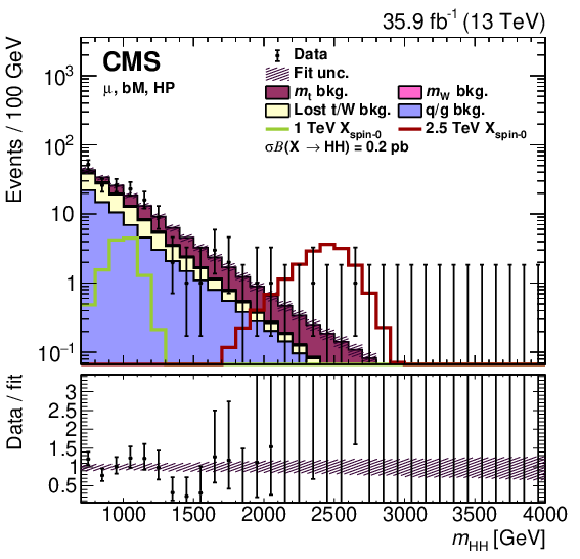
png pdf |
Figure 6-d:
The fit result compared to data projected in ${m_{{\mathrm {H}} {\mathrm {H}}}}$ for the muon $\mu$, bM, HP event category. The fit result is the filled histogram, with the different colors indicating different background categories. The background shape uncertainty is shown as the hatched band. Example spin-0 signal distributions for $ {m_{{\text {X}}}} $ of 1 and 2.5 TeV are shown as solid lines, with the product of the cross section and branching fraction to two Higgs bosons set to 0.2 pb. The lower panel shows ratio of the data to the fit result. |

png pdf |
Figure 6-e:
The fit result compared to data projected in ${m_{{\mathrm {H}} {\mathrm {H}}}}$ for the muon $\mu$, bT, LP event category. The fit result is the filled histogram, with the different colors indicating different background categories. The background shape uncertainty is shown as the hatched band. Example spin-0 signal distributions for $ {m_{{\text {X}}}} $ of 1 and 2.5 TeV are shown as solid lines, with the product of the cross section and branching fraction to two Higgs bosons set to 0.2 pb. The lower panel shows ratio of the data to the fit result. |

png pdf |
Figure 6-f:
The fit result compared to data projected in ${m_{{\mathrm {H}} {\mathrm {H}}}}$ for the muon $\mu$, bT, HP event category. The fit result is the filled histogram, with the different colors indicating different background categories. The background shape uncertainty is shown as the hatched band. Example spin-0 signal distributions for $ {m_{{\text {X}}}} $ of 1 and 2.5 TeV are shown as solid lines, with the product of the cross section and branching fraction to two Higgs bosons set to 0.2 pb. The lower panel shows ratio of the data to the fit result. |

png pdf |
Figure 7:
Observed and expected 95% CL upper limits on the product of the cross section and branching fraction to HH for a generic spin-0 (left) and spin-2 (right) boson X, as a function of mass. Example radion and bulk graviton predictions are also shown. The HH branching fraction is assumed to be 25 and 10%, respectively. |
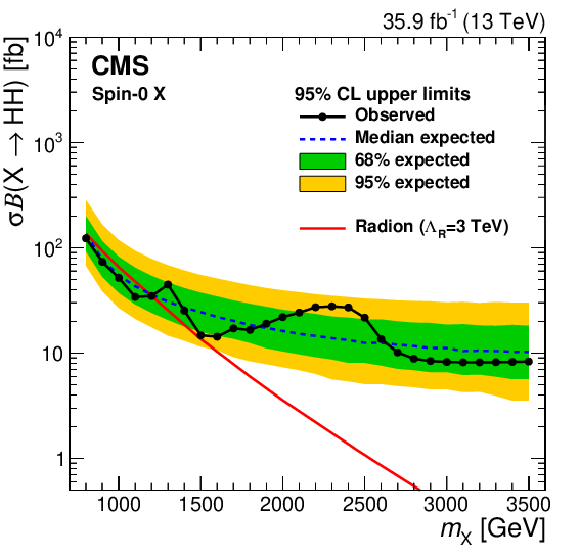
png pdf |
Figure 7-a:
Observed and expected 95% CL upper limits on the product of the cross section and branching fraction to HH for a generic spin-0 boson X, as a function of mass. Example radion predictions are also shown. The HH branching fraction is assumed to be 25%. |

png pdf |
Figure 7-b:
Observed and expected 95% CL upper limits on the product of the cross section and branching fraction to HH for a generic spin-2 boson X, as a function of mass. Example bulk graviton predictions are also shown. The HH branching fraction is assumed to be 10%. |
| Tables | |

png pdf |
Table 1:
Event categorization and corresponding category labels. The 12 independent event categories are formed by applying a single selection from each of the three categorization types. For the ${{{\mathrm {b}} {\overline {\mathrm {b}}}} \text {jet}}$ subjet b tagging type, "medium'' refers to the subjets that pass the medium b tagging operating point and "loose'' refers to those that pass the loose, but not the medium, operating point. |

png pdf |
Table 2:
The four exclusive background categories with their kinematical properties and defining number of generator-level quarks within $ {\Delta R} <$ 0.8 of the ${{{\mathrm {b}} {\overline {\mathrm {b}}}} \text {jet}}$ axis. |
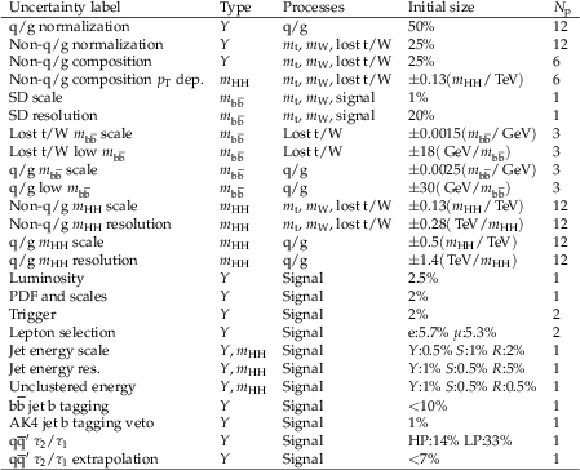
png pdf |
Table 3:
The systematic uncertainties included in the maximum likelihood fit. The "type'' indicates if the uncertainty affects process yield $Y$ or the shape of the ${m_{{{\mathrm {b}} {\overline {\mathrm {b}}}}}}$ or ${m_{{\mathrm {H}} {\mathrm {H}}}}$ distributions. The processes that they are assigned to, their initial sizes, and the number of independent nuisance parameters, $N_\text {p}$, for each uncertainty are listed. Uncertainty sizes that vary by event category are listed with category labels. The labels $Y$, $S$, and $R$ denote how a single uncertainty affects yield, scale, and resolution, respectively. |
| Summary |
| A search has been presented for new particles decaying to a pair of Higgs bosons (H) where one decays into a bottom quark pair ($\mathrm{b\bar{b}}$) and the other into two W bosons that subsequently decay into a lepton, a neutrino, and a quark pair. The large Lorentz boost of the Higgs bosons leads to the distinct experimental signature of one large-radius jet with substructure consistent with the decay $\mathrm{H}\to\mathrm{b\bar{b}}$ and a second large-radius jet with a nearby isolated lepton consistent with the decay $\mathrm{H}\to\mathrm{W}\mathrm{W}^*$. This search uses a sample of proton-proton collisions collected at $\sqrt{s} = $ 13 TeV by the CMS detector, corresponding to an integrated luminosity of 35.9 fb$^{-1}$ . The primary standard model background, top quark pair production, is suppressed by reconstructing the HH decay chain and applying mass constraints. The signal and background yields are estimated by a two-dimensional template fit in the plane of the ${\mathrm{b\bar{b}} \text{jet}}$ mass and the HH resonance mass. The templates are validated in a variety of data control regions and are shown to model the data well. The data are consistent with the expected standard model background. The results represent upper limits on the product of cross section and branching fraction for new bosons decaying to HH. The observed limit at 95% confidence level for a spin-0 resonance ranges from 123 fb at 0.8 TeV to 8.3 fb at 3.5 TeV, while the limit for a spin-2 resonance is 103 fb at 0.8 TeV and 7.8 fb at 3.5 TeV. These are the best results to date from searches for an HH resonance decaying to this final state. The results are comparable to the results from searches in other channels for resonances with masses below 1.5 TeV. |
| References | ||||
| 1 | ATLAS Collaboration | Observation of a new particle in the search for the standard model Higgs boson with the ATLAS detector at the LHC | PLB 716 (2012) 01 | 1207.7214 |
| 2 | CMS Collaboration | Observation of a new boson at a mass of 125 GeV with the CMS experiment at the LHC | PLB 716 (2012) 30 | CMS-HIG-12-028 1207.7235 |
| 3 | CMS Collaboration | Observation of a new boson with mass near 125 GeV in pp collisions at $ \sqrt{s} = $ 7 and 8 TeV | JHEP 06 (2013) 081 | CMS-HIG-12-036 1303.4571 |
| 4 | F. Englert and R. Brout | Broken symmetry and the mass of gauge vector mesons | PRL 13 (1964) 321 | |
| 5 | P. W. Higgs | Broken symmetries and the masses of gauge bosons | PRL 13 (1964) 508 | |
| 6 | G. C. Branco et al. | Theory and phenomenology of two-Higgs-doublet models | PR 516 (2012) 1 | 1106.0034 |
| 7 | P. Ramond | Dual theory for free fermions | PRD 3 (1971) 2415 | |
| 8 | Y. A. Golfand and E. P. Likhtman | Extension of the algebra of Poincar$ \'e $ group generators and violation of P invariance | JEPTL 13 (1971)323 | |
| 9 | A. Neveu and J. H. Schwarz | Factorizable dual model of pions | NPB 31 (1971) 86 | |
| 10 | D. V. Volkov and V. P. Akulov | Possible universal neutrino interaction | JEPTL 16 (1972)438 | |
| 11 | J. Wess and B. Zumino | A Lagrangian model invariant under supergauge transformations | PLB 49 (1974) 52 | |
| 12 | J. Wess and B. Zumino | Supergauge transformations in four dimensions | NPB 70 (1974) 39 | |
| 13 | P. Fayet | Supergauge invariant extension of the Higgs mechanism and a model for the electron and its neutrino | NPB 90 (1975) 104 | |
| 14 | H. P. Nilles | Supersymmetry, supergravity and particle physics | Phys. Rep. 110 (1984) 1 | |
| 15 | L. Randall and R. Sundrum | A large mass hierarchy from a small extra dimension | PRL 83 (1999) 3370 | hep-ph/9905221 |
| 16 | W. D. Goldberger and M. B. Wise | Modulus stabilization with bulk fields | PRL 83 (1999) 4922 | hep-ph/9907447 |
| 17 | O. DeWolfe, D. Z. Freedman, S. S. Gubser, and A. Karch | Modeling the fifth dimension with scalars and gravity | PRD 62 (2000) 046008 | hep-th/9909134 |
| 18 | C. Csaki, M. Graesser, L. Randall, and J. Terning | Cosmology of brane models with radion stabilization | PRD 62 (2000) 045015 | hep-ph/9911406 |
| 19 | C. Csaki, M. L. Graesser, and G. D. Kribs | Radion dynamics and electroweak physics | PRD 63 (2001) 065002 | hep-th/0008151 |
| 20 | H. Davoudiasl, J. L. Hewett, and T. G. Rizzo | Phenomenology of the Randall-Sundrum gauge hierarchy model | PRL 84 (2000) 2080 | hep-ph/9909255 |
| 21 | K. Agashe, H. Davoudiasl, G. Perez, and A. Soni | Warped gravitons at the LHC and beyond | PRD 76 (2007) 036006 | hep-ph/0701186 |
| 22 | A. L. Fitzpatrick, J. Kaplan, L. Randall, and L.-T. Wang | Searching for the Kaluza-Klein graviton in bulk RS models | JHEP 09 (2007) 013 | hep-ph/0701150 |
| 23 | ATLAS Collaboration | Searches for Higgs boson pair production in the $ hh\to bb\tau\tau, \gamma\gamma WW^*, \gamma\gamma bb, bbbb $ channels with the ATLAS detector | PRD 92 (2015) 092004 | 1509.04670 |
| 24 | ATLAS Collaboration | Search for a new resonance decaying to a $ W $ or $ Z $ boson and a Higgs boson in the $ \ell \ell / \ell \nu / \nu \nu + b \bar{b} $ final states with the ATLAS detector | EPJC 75 (2015) 263 | 1503.08089 |
| 25 | ATLAS Collaboration | Search for Higgs boson pair production in the $ b\bar{b}b\bar{b} $ final state from pp collisions at $ \sqrt{s} = $ 8 TeV with the ATLAS detector | EPJC 75 (2015) 412 | 1506.00285 |
| 26 | ATLAS Collaboration | Search for Higgs boson pair production in the $ \gamma\gamma b\bar{b} $ final state using pp collision data at $ \sqrt{s}= $ 8 TeV from the ATLAS detector | PRL 114 (2015) 081802 | 1406.5053 |
| 27 | ATLAS Collaboration | Search for $ W\!Z $ resonances in the fully leptonic channel using $ pp $ collisions at $ \sqrt{s} = $ 8 TeV with the ATLAS detector | PLB 737 (2014) 223 | 1406.4456 |
| 28 | ATLAS Collaboration | Search for heavy resonances decaying to a $ W $ or $ Z $ boson and a Higgs boson in the $ q\bar{q}^{(\prime)}b\bar{b} $ final state in $ pp $ collisions at $ \sqrt{s} = $ 13 TeV with the ATLAS detector | PLB 774 (2017) 494 | 1707.06958 |
| 29 | ATLAS Collaboration | Search for $ WW/WZ $ resonance production in $ \ell \nu qq $ final states in $ pp $ collisions at $ \sqrt{s} = $ 13 TeV with the ATLAS detector | JHEP 03 (2018) 042 | 1710.07235 |
| 30 | ATLAS Collaboration | Search for resonant $ WZ $ production in the fully leptonic final state in proton-proton collisions at $ \sqrt{s} = $ 13 TeV with the ATLAS detector | PLB 787 (2018) 68 | 1806.01532 |
| 31 | ATLAS Collaboration | Search for heavy resonances decaying into $ WW $ in the $ e\nu\mu\nu $ final state in $ pp $ collisions at $ \sqrt{s}= $ 13 TeV with the ATLAS detector | EPJC 78 (2018) 24 | 1710.01123 |
| 32 | ATLAS Collaboration | Searches for heavy $ ZZ $ and $ ZW $ resonances in the $ \ell\ell qq $ and $ \nu\nu qq $ final states in $ pp $ collisions at $ \sqrt{s}= $ 13 TeV with the ATLAS detector | JHEP 03 (2018) 009 | 1708.09638 |
| 33 | ATLAS Collaboration | Search for heavy ZZ resonances in the $ \ell ^+\ell ^-\ell ^+\ell ^- $ and $ \ell ^+\ell ^-\nu \bar{\nu} $ final states using proton-proton collisions at $ \sqrt{s}= $ 13 TeV with the ATLAS detector | EPJC 78 (2018) 293 | 1712.06386 |
| 34 | ATLAS Collaboration | Search for heavy resonances decaying into a $ W $ or $ Z $ boson and a Higgs boson in final states with leptons and $ b $-jets in 36 fb$ ^{-1} $ of $ \sqrt s = $ 13 TeV pp collisions with the ATLAS detector | JHEP 03 (2018) 174 | 1712.06518 |
| 35 | ATLAS Collaboration | Search for diboson resonances with boson-tagged jets in $ pp $ collisions at $ \sqrt{s}= $ 13 TeV with the ATLAS detector | PLB 777 (2018) 91 | 1708.04445 |
| 36 | ATLAS Collaboration | Search for Higgs boson pair production in the $ b\bar{b}WW^{*} $ decay mode at $ \sqrt{s}= $ 13 TeV with the ATLAS detector | Submitted to JHEP | 1811.04671 |
| 37 | CMS Collaboration | Combination of searches for heavy resonances decaying to WW, WZ, ZZ, WH, and ZH boson pairs in proton-proton collisions at $ \sqrt{s}= $ 8 and 13 TeV | PLB 774 (2017) 533 | CMS-B2G-16-007 1705.09171 |
| 38 | CMS Collaboration | Search for a heavy resonance decaying into a Z boson and a vector boson in the $ \nu\overline{\nu}\mathrm{q}\overline{\mathrm{q}} $ final state | JHEP 07 (2018) 075 | CMS-B2G-17-005 1803.03838 |
| 39 | CMS Collaboration | Search for heavy resonances decaying into two Higgs bosons or into a Higgs boson and a W or Z boson in proton-proton collisions at 13 TeV | JHEP 01 (2019) 051 | CMS-B2G-17-006 1808.01365 |
| 40 | CMS Collaboration | Search for a heavy resonance decaying into a Z boson and a Z or W boson in 2$ \ell $2q final states at $ \sqrt{s}= $ 13 TeV | JHEP 09 (2018) 101 | CMS-B2G-17-013 1803.10093 |
| 41 | CMS Collaboration | Search for production of Higgs boson pairs in the four b quark final state using large-area jets in proton-proton collisions at $ \sqrt{s}= $ 13 TeV | JHEP 01 (2019) 040 | CMS-B2G-17-019 1808.01473 |
| 42 | CMS Collaboration | Searches for a heavy scalar boson H decaying to a pair of 125 GeV Higgs bosons hh or for a heavy pseudoscalar boson A decaying to Zh, in the final states with $ \text{h} \to \tau \tau $ | PLB 755 (2016) 217 | CMS-HIG-14-034 1510.01181 |
| 43 | CMS Collaboration | Search for massive resonances decaying into WW, WZ, ZZ, qW, and qZ with dijet final states at $ \sqrt{s}= $ 13 TeV | PRD 97 (2018) 072006 | CMS-B2G-17-001 1708.05379 |
| 44 | CMS Collaboration | Search for heavy resonances that decay into a vector boson and a Higgs boson in hadronic final states at $ \sqrt{s} = $ 13 TeV | EPJC 77 (2017) 636 | CMS-B2G-17-002 1707.01303 |
| 45 | CMS Collaboration | Search for heavy resonances decaying into a vector boson and a Higgs boson in final states with charged leptons, neutrinos and b quarks at $ \sqrt{s}= $ 13 TeV | JHEP 11 (2018) 172 | CMS-B2G-17-004 1807.02826 |
| 46 | CMS Collaboration | Search for resonant pair production of Higgs bosons decaying to two bottom quark-antiquark pairs in proton-proton collisions at 8 TeV | PLB 749 (2015) 560 | CMS-HIG-14-013 1503.04114 |
| 47 | CMS Collaboration | Search for heavy resonances decaying into a vector boson and a Higgs boson in final states with charged leptons, neutrinos, and b quarks | PLB 768 (2017) 137 | CMS-B2G-16-003 1610.08066 |
| 48 | CMS Collaboration | Search for a massive resonance decaying to a pair of Higgs bosons in the four b quark final state in proton-proton collisions at $ \sqrt{s}= $ 13 TeV | PLB 781 (2018) 244 | 1710.04960 |
| 49 | CMS Collaboration | Search for a heavy resonance decaying to a pair of vector bosons in the lepton plus merged jet final state at $ \sqrt{s}= $ 13 TeV | JHEP 05 (2018) 088 | CMS-B2G-16-029 1802.09407 |
| 50 | CMS Collaboration | Search for massive resonances decaying into WW, WZ or ZZ bosons in proton-proton collisions at $ \sqrt{s} = $ 13 TeV | JHEP 03 (2017) 162 | CMS-B2G-16-004 1612.09159 |
| 51 | CMS Collaboration | Search for ZZ resonances in the 2$ \ell 2 \nu $ final state in proton-proton collisions at 13 TeV | JHEP 03 (2018) 003 | CMS-B2G-16-023 1711.04370 |
| 52 | CMS Collaboration | Search for new resonances decaying via WZ to leptons in proton-proton collisions at $ \sqrt{s} = $ 13 TeV | PLB 740 (2015) 83 | CMS-EXO-12-025 1407.3476 |
| 53 | CMS Collaboration | Search for massive WH resonances decaying into the $ \ell \nu \mathrm{b} \overline{\mathrm{b}} $ final state at $ \sqrt{s} = $ 8 TeV | EPJC 76 (2016) 237 | CMS-EXO-14-010 1601.06431 |
| 54 | CMS Collaboration | Search for a massive resonance decaying into a Higgs boson and a W or Z boson in hadronic final states in proton-proton collisions at $ \sqrt{s} = $ 8 TeV | JHEP 02 (2016) 145 | CMS-EXO-14-009 1506.01443 |
| 55 | CMS Collaboration | Search for narrow high-mass resonances in proton-proton collisions at $ \sqrt{s} = $ 8 TeV decaying to a Z and a Higgs boson | PLB 748 (2015) 255 | CMS-EXO-13-007 1502.04994 |
| 56 | CMS Collaboration | The CMS trigger system | JINST 12 (2017) P01020 | CMS-TRG-12-001 1609.02366 |
| 57 | CMS Collaboration | The CMS experiment at the CERN LHC | JINST 3 (2008) S08004 | CMS-00-001 |
| 58 | J. Alwall et al. | The automated computation of tree-level and next-to-leading order differential cross sections, and their matching to parton shower simulations | JHEP 07 (2014) 079 | 1405.0301 |
| 59 | J. Alwall et al. | Comparative study of various algorithms for the merging of parton showers and matrix elements in hadronic collisions | EPJC 53 (2008) 473 | 0706.2569 |
| 60 | R. Frederix and S. Frixione | Merging meets matching in MC@NLO | JHEP 12 (2012) 061 | 1209.6215 |
| 61 | P. Nason | A new method for combining NLO QCD with shower Monte Carlo algorithms | JHEP 11 (2004) 040 | hep-ph/0409146 |
| 62 | S. Frixione, P. Nason, and C. Oleari | Matching NLO QCD computations with parton shower simulations: the POWHEG method | JHEP 11 (2007) 070 | 0709.2092 |
| 63 | S. Alioli, P. Nason, C. Oleari, and E. Re | A general framework for implementing NLO calculations in shower Monte Carlo programs: the POWHEG BOX | JHEP 06 (2010) 043 | 1002.2581 |
| 64 | E. Re | Single-top Wt-channel production matched with parton showers using the POWHEG method | EPJC 71 (2011) 1547 | 1009.2450 |
| 65 | T. Melia, P. Nason, R. Rontsch, and G. Zanderighi | $ W^+W^- $, $ WZ $ and $ ZZ $ production in the POWHEG BOX | JHEP 11 (2011) 078 | 1107.5051 |
| 66 | P. Nason and G. Zanderighi | $ W^+ W^- $, $ W Z $ and $ Z Z $ production in the POWHEG-BOX-V2 | EPJC 74 (2014) 2702 | 1311.1365 |
| 67 | R. Frederix, E. Re, and P. Torrielli | Single-top $ t $-channel hadroproduction in the four-flavour scheme with POWHEG and aMC@NLO | JHEP 09 (2012) 130 | 1207.5391 |
| 68 | H. B. Hartanto, B. Jager, L. Reina, and D. Wackeroth | Higgs boson production in association with top quarks in the POWHEG BOX | PRD 91 (2015) 094003 | 1501.04498 |
| 69 | T. Sjostrand et al. | An introduction to PYTHIA 8.2 | CPC 191 (2015) 159 | 1410.3012 |
| 70 | CMS Collaboration | Event generator tunes obtained from underlying event and multiparton scattering measurements | EPJC 76 (2016) 155 | CMS-GEN-14-001 1512.00815 |
| 71 | R. D. Ball et al. | Impact of heavy quark masses on parton distributions and LHC phenomenology | NPB 849 (2011) 296 | 1101.1300 |
| 72 | GEANT4 Collaboration | GEANT4--a simulation toolkit | NIMA 506 (2003) 250 | |
| 73 | CMS Collaboration | Particle-flow reconstruction and global event description with the CMS detector | JINST 12 (2017) P10003 | CMS-PRF-14-001 1706.04965 |
| 74 | M. Cacciari, G. P. Salam, and G. Soyez | The anti-$ {k_{\mathrm{T}}} $ jet clustering algorithm | JHEP 04 (2008) 063 | 0802.1189 |
| 75 | M. Cacciari, G. P. Salam, and G. Soyez | FastJet user manual | EPJC 72 (2012) 1896 | 1111.6097 |
| 76 | CMS Collaboration | Performance of electron reconstruction and selection with the CMS detector in proton-proton collisions at $ \sqrt{s} = $ 8 TeV | JINST 10 (2015) P06005 | CMS-EGM-13-001 1502.02701 |
| 77 | CMS Collaboration | Performance of the CMS muon detector and muon reconstruction with proton-proton collisions at $ \sqrt{s} = $ 13 TeV | JINST 13 (2018) P06015 | CMS-MUO-16-001 1804.04528 |
| 78 | K. Rehermann and B. Tweedie | Efficient identification of boosted semileptonic top quarks at the LHC | JHEP 03 (2011) 059 | 1007.2221 |
| 79 | CMS Collaboration | Measurements of inclusive W and Z cross sections in pp collisions at $ \sqrt{s}= $ 7 TeV | JHEP 01 (2011) 080 | CMS-EWK-10-002 1012.2466 |
| 80 | D. Bertolini, P. Harris, M. Low, and N. Tran | Pileup per particle identification | JHEP 10 (2014) 059 | 1407.6013 |
| 81 | CMS Collaboration | Jet algorithms performance in 13 TeV data | CMS-PAS-JME-16-003 | CMS-PAS-JME-16-003 |
| 82 | CMS Collaboration | Jet energy scale and resolution in the CMS experiment in pp collisions at 8 TeV | JINST 12 (2017) P02014 | CMS-JME-13-004 1607.03663 |
| 83 | CMS Collaboration | Jet algorithms performance in 13 TeV data | ||
| 84 | Y. L. Dokshitzer, G. D. Leder, S. Moretti, and B. R. Webber | Better jet clustering algorithms | JHEP 08 (1997) 001 | hep-ph/9707323 |
| 85 | M. Wobisch and T. Wengler | Hadronization corrections to jet cross-sections in deep inelastic scattering | in Proceedings of the Workshop on Monte Carlo Generators for HERA Physics, Hamburg, Germany, p. 270 1998 | hep-ph/9907280 |
| 86 | M. Dasgupta, A. Fregoso, S. Marzani, and G. P. Salam | Towards an understanding of jet substructure | JHEP 09 (2013) 029 | 1307.0007 |
| 87 | J. M. Butterworth, A. R. Davison, M. Rubin, and G. P. Salam | Jet substructure as a new Higgs search channel at the LHC | PRL 100 (2008) 242001 | 0802.2470 |
| 88 | A. J. Larkoski, S. Marzani, G. Soyez, and J. Thaler | Soft drop | JHEP 05 (2014) 146 | 1402.2657 |
| 89 | J. Thaler and K. Van Tilburg | Identifying boosted objects with N-subjettiness | JHEP 03 (2011) 015 | 1011.2268 |
| 90 | S. Catani, Y. L. Dokshitzer, M. H. Seymour, and B. R. Webber | Longitudinally invariant $ k_\perp $ clustering algorithms for hadron hadron collisions | NPB 406 (1993) 187 | |
| 91 | ATLAS and CMS Collaborations | Combined measurement of the Higgs boson mass in $ pp $ collisions at $ \sqrt{s}= $ 7 and 8 TeV with the ATLAS and CMS experiments | PRL 114 (2015) 191803 | 1503.07589 |
| 92 | CMS Collaboration | Identification of heavy-flavour jets with the CMS detector in pp collisions at 13 TeV | JINST 13 (2018) P05011 | CMS-BTV-16-002 1712.07158 |
| 93 | CMS Collaboration | Performance of missing transverse momentum in pp collisions at $ \sqrt{s} = $ 13 TeV using the CMS detector | CMS-PAS-JME-17-001 | CMS-PAS-JME-17-001 |
| 94 | M. Rosenblatt | Remarks on some nonparametric estimates of a density function | Ann. Math. Statist. 27 (1956) 832 | |
| 95 | B. W. Silverman | Density estimation for statistics and data analysis | Chapman and Hall, 1986 ISBN 0412246201 | |
| 96 | K. S. Cranmer | Kernel estimation in high-energy physics | CPC 136 (2001) 198 | hep-ex/0011057 |
| 97 | D. W. Scott | Multivariate density estimation: theory, practice, and visualization | John Wiley and Sons, 1992 ISBN 0471547700 | |
| 98 | M. J. Oreglia | A study of the reactions $\psi' \to \gamma\gamma \psi$ | PhD thesis, Stanford University, 1980 SLAC Report SLAC-R-236, see Appendix D | |
| 99 | J. Gaiser | Charmonium Spectroscopy From Radiative Decays of the $\mathrm{J}/\psi$ | PhD thesis, SLAC | |
| 100 | CMS Collaboration | CMS luminosity measurements for the 2016 data taking period | CMS-PAS-LUM-17-001 | CMS-PAS-LUM-17-001 |
| 101 | M. Cacciari et al. | The $ \mathrm{t\bar{t}} $ cross-section at 1.8 TeV and 1.96 TeV: A study of the systematics due to parton densities and scale dependence | JHEP 04 (2004) 068 | hep-ph/0303085 |
| 102 | S. Catani, D. de Florian, M. Grazzini, and P. Nason | Soft gluon resummation for Higgs boson production at hadron colliders | JHEP 07 (2003) 028 | hep-ph/0306211 |
| 103 | S. Baker and R. D. Cousins | Clarification of the use of chi square and likelihood functions in fits to histograms | NIM221 (1984) 437 | |
| 104 | G. Cowan, K. Cranmer, E. Gross, and O. Vitells | Asymptotic formulae for likelihood-based tests of new physics | EPJC 71 (2011) 1554 | 1007.1727 |
| 105 | T. Junk | Confidence level computation for combining searches with small statistics | NIMA 434 (1999) 435 | hep-ex/9902006 |
| 106 | A. L. Read | Presentation of search results: The CLs technique | JPG 28 (2002) 2693 | |
| 107 | A. Oliveira | Gravity particles from warped extra dimensions, predictions for LHC | 1404.0102 | |
| 108 | M. Gouzevitch et al. | Scale-invariant resonance tagging in multijet events and new physics in Higgs pair production | JHEP 07 (2013) 148 | 1303.6636 |

|
Compact Muon Solenoid LHC, CERN |

|

|

|

|

|

|